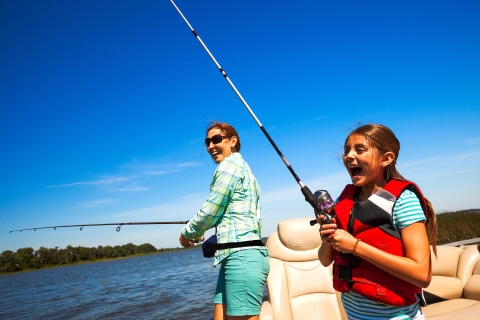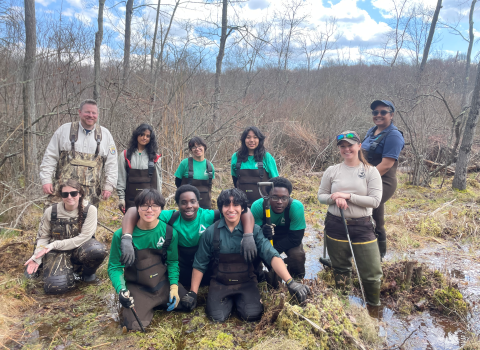For more than half a century, America’s fishing equipment manufacturers have shared a partnership with state and federal biologists through the Dingell-Johnson Act — a partnership that uses excise tax to fund remarkable fisheries conservation and recreation. Each year the U.S. Fish and Wildlife Service’s Office of Conservation Investment distributes millions of dollars in grants funded through this excise tax paid by manufacturers.
Revenue for these grants is generated from manufacturers’ excise taxes on sport fishing equipment, import duties on fishing tackle and pleasure boats, and a portion of the gasoline fuel tax attributable to small engines and motorboats. Learn more about the programs and grants supported by the makers of your favorite equipment:
Sport Fish Restoration: The Sport Fish Restoration Program was created in 1950 to restore and better manage America's declining fish resources. Since the Act was passed, it has generated over $8 billion for the conservation and restoration of sport fish species and their habitats. These funds also support connecting people with nature through outdoor recreational opportunities. Every year, 1 billion fish of more than 77 species are produced by 321 state fish hatcheries across the country— all funded by Sport Fish Restoration grants using excise tax dollars.
Aquatic Education: Aquatic Resource Education grants, authorized through the Sport Fish Restoration Act, provide funds to states, the District of Columbia and territory fish and wildlife agencies for aquatic resource education programs. The purpose of these funds is to enhance the public's understanding of aquatic resources and sportfishing, and to promote the development of responsible attitudes and ethics toward the aquatic environment. Examples of funded projects include: basic angling classes targeted primarily to youth, water safety, free fishing events for families, Learn-to-Fish workshops targeting primarily new adult anglers, and aquatic biology classes. Every year, about 1.5 million people receive aquatic education supported by excise tax funds.
- Learn about the Aquatic Resource Education grant supported fishing and boating camps hosted by the Florida Conservation Commission.
- Exploring Aquatic Education Through Microfishing in Texas.
Boating Access for Recreation: Boating Access grants, managed under the Sport Fish Restoration Grant Program, provides federal funds for facilities that create or add public access for recreational boating and improvements to waterways. Grants are provided to state fish and wildlife agencies that sometimes partner with local governments, other state agencies, or non-governmental organizations to ensure public access to state waters. Types of efforts that are funded with Boating Access grants include projects that seek to develop, renovate, maintain, or improve facilities for recreational boating access. Funded projects include boat ramps, restroom facilities, and other efforts to increase boater access to waterways. All facilities funded through the subprogram are available to all recreational boaters.
Large Vessel Infrastructure: The Boating Infrastructure Grants, also known as BIG, provide funds to state agencies for tie-up and support facilities for transient recreational vessels greater than 26 feet in length for stays of up to 15 days. Established in 1998, BIG funds projects designed to improve docking and comfort facilities to better accommodate these large vessels. These projects have many benefits including, strengthening local community ties to transient boaters and marine manufacturers, promoting public-private partnerships and entrepreneurial opportunities, providing continuity of access to waterfront communities, and providing awareness of transient boating opportunities and areas of safe harbor for transient boaters.
- Learn more about the $21 million in BIG funds awarded in 2024.
- BIG Provides Shelter from the Storm: The Port Authority of Guam Restores Harbor of Refuge with Boating Infrastructure Grants.
Clean Waterways: Clean Vessel Act grants, known as CVA, provide funding to state agencies for the construction, renovation, operation, and maintenance of pump-out stations and waste reception facilities to meet the needs of recreational boaters. States also use CVA grant funds to provide educational information to the public about environmental pollution and health problems that result from direct sewage discharge into water. These grants provide a multitude of human and wildlife benefits including protecting sensitive fish habitat, enhancing shellfish beds that are important economically and environmentally, and ensuring safe fishing and swimming areas free of pollution from recreational boats. The state of Washington alone has received over $21 million in federal grants for clean waterways. In Washington, CVA funds support nearly 140 marine sewage disposal projects and continue to support ongoing operations and maintenance for stationary pumpouts and dump stations and free mobile pumpout services at 10 coastal marinas. This has preventedmillions of gallons of sewage from contaminating Washington’s waters.
Wetlands Conservation: National Coastal Wetlands Conservation grants are a competitive program that provides funding for long-term conservation of coastal wetland ecosystems by helping states and territories to protect, restore, and enhance coastal habitats. Created in 1990, this program has funded projects for the acquisition of coastal lands or waters, restoration and enhancement of wetlands, and the management of coastal wetlands ecosystems. According to a 2009 study, wetlands in coastal watersheds are lost at an average rate of 80,000 acres per year. Conservation of these habitats, funded through the excise tax administered by the Office of Conservation Investment, benefit coastal wetland-dependent wildlife and provide economic benefits and recreational opportunities for anglers, boaters, hunters, and wildlife watchers. Coastal wetlands play an important role in reducing flooding from storm surge and in stabilizing shorelines in the face of sea-level rise.
- Learn more about the National Coastal Wetlands Conservation Grants.
- Service Awards $10.8 Million To Protect and Restore Coastal Wetlands and Build Coastal Resiliency in 2024.
Multistate Conservation: Multistate Conservation Grants provide funding for wildlife and sport fish restoration projects identified as priority projects by the Association of Fish and Wildlife Agencies (AFWA). These high priority projects address problems affecting states on a regional or national basis. Projects can include species population surveys, outreach, data collection regarding hunter or angler participation, hunter or aquatic education, economic value of fishing and hunting, and regional or multistate habitat needs assessments. AFWA and the Office of Conservation Investment cooperatively manage the grants. Each year, $6 million is provided: $3 million from the Sport Fish Restoration and Boating Trust Fund and $3 million from the Wildlife Restoration Account.




